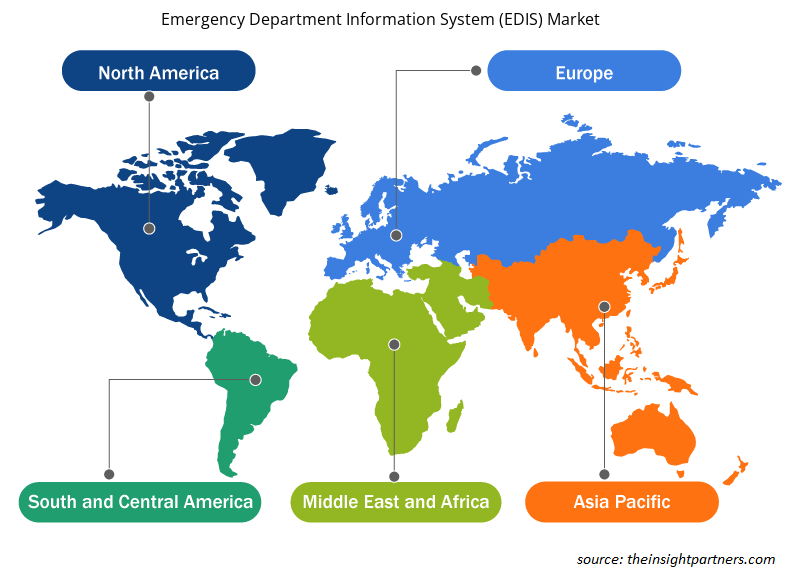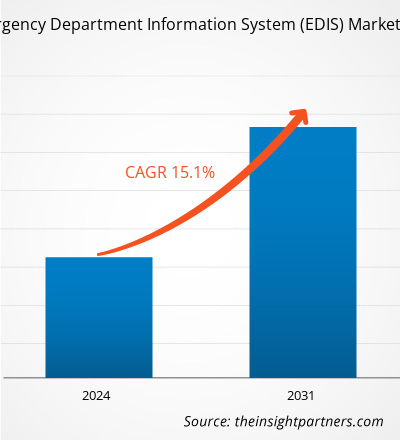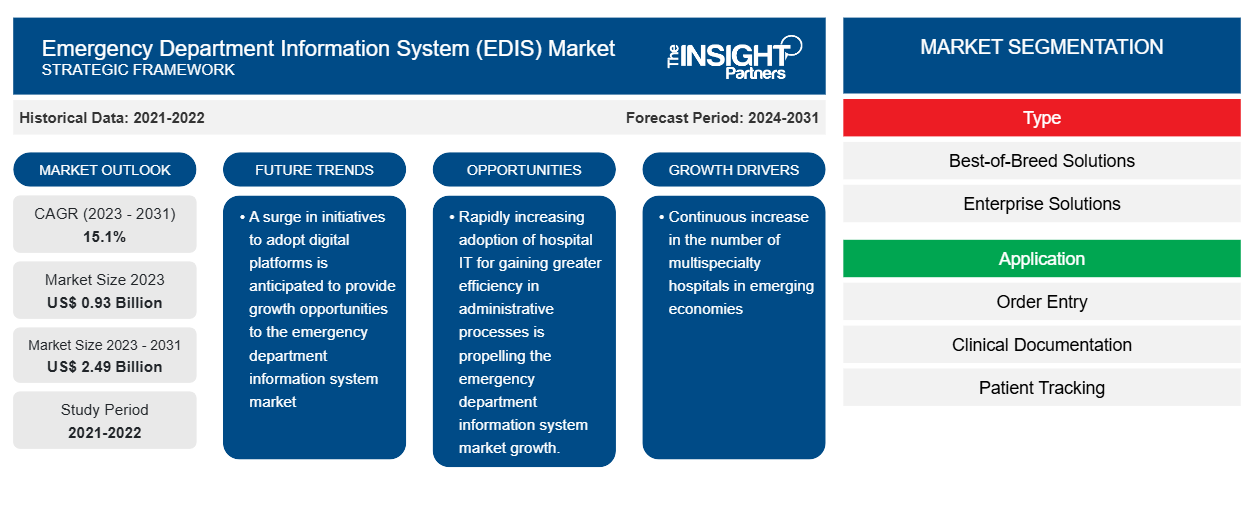Le marché des systèmes d'information des services d'urgence (EDIS) devrait atteindre 2,49 milliards USD d'ici 2031, contre 0,93 milliard USD en 2023. Le marché devrait enregistrer un TCAC de 15,10 % au cours de la période 2023-2031. L'émergence de services EDIS basés sur le cloud restera probablement une tendance clé du marché.EDIS) market size is projected to reach US$ 2.49 billion by 2031 from US$ 0.93 billion in 2023. The market is expected to register a CAGR of 15.10% during 2023–2031. The emergence of cloud-based EDIS services will likely remain a key trend in the market.
Analyse du marché des systèmes d'information des services d'urgence (EDIS)
Les principaux facteurs qui stimulent la croissance du marché sont l’augmentation du flux de patients dans les services d’urgence et un taux élevé d’adoption des systèmes d’information des services d’urgence. En outre, les progrès dans la numérisation des services de santé offriront probablement des opportunités au marché des systèmes d’information des services d’urgence (EDIS) dans les années à venir.
Aperçu du marché des systèmes d'information des services d'urgence (EDIS)
Les services médicaux d'urgence (EMS) sont chargés des soins intensifs aux patients. Les services EMS gèrent les patients présentant des complications médicales, ainsi que les urgences obstétricales et chirurgicales. Ces services traitent également les blessures, les infections, les crises cardiaques , les accidents vasculaires cérébraux, l'asthme et les complications aiguës de la grossesse. Ainsi, ils se concentrent principalement sur les soins aux patients blessés et aux maladies urgentes, telles que les accidents vasculaires cérébraux et les arrêts cardiaques. Les services requis en cas de catastrophes naturelles sont également inclus dans la catégorie EMS. La demande de services de soins d'urgence dans les établissements de santé augmente en raison de l'incidence croissante des arrêts cardiaques et des accidents. Selon le Conseil européen de réanimation, l'incidence déclarée des arrêts cardiaques en Europe est d'environ 67 à 170 pour 100 000 personnes. Selon les estimations fournies par stroke.org.uk, le fardeau des accidents vasculaires cérébraux en Europe devrait augmenter considérablement dans les années à venir. Les projections de ce rapport indiquent qu’il y aura une augmentation de 34 % du nombre total de cas d’accident vasculaire cérébral dans l’Union européenne au cours de la période 2015-2035, le nombre de cas atteignant probablement 819 771 d’ici 2035, contre 613 148 en 2015. Par conséquent, le flux de patients dans les services d’urgence devrait augmenter dans les années à venir.stroke.org.uk, the burden of stroke in Europe is expected to grow remarkably in the coming years. The projections in this report indicate that there will be a 34% increase in the total number of stroke cases in the European Union during 2015–2035, as the case count is likely to reach 819,771 by 2035 from 613,148 in 2015. Therefore, the flow of patients in emergency departments is expected to rise in the coming years.
Personnalisez ce rapport en fonction de vos besoins
Vous bénéficierez d'une personnalisation gratuite de n'importe quel rapport, y compris de certaines parties de ce rapport, d'une analyse au niveau des pays, d'un pack de données Excel, ainsi que de superbes offres et réductions pour les start-ups et les universités.
-
Obtenez les principales tendances clés du marché de ce rapport.Cet échantillon GRATUIT comprendra une analyse de données, allant des tendances du marché aux estimations et prévisions.
Moteurs et opportunités du marché des systèmes d'information des services d'urgence (EDIS)EDIS) Market Drivers and Opportunities
Adoption élevée des systèmes d'information des services d'urgence
Les systèmes d'information des services d'urgence (EDIS) améliorent l'utilisation du personnel et des ressources de santé, ce qui permet de gérer le flux de patients. Les systèmes contribuent également à améliorer la prise de décision des hôpitaux en fournissant des données complètes en temps réel aux administrations hospitalières. Les solutions EDIS réduisent le coût des établissements de santé en diminuant les coûts de main-d'œuvre. En outre, la demande de systèmes d'information des services d'urgence est élevée en Amérique du Nord en raison de la large acceptation de la technologie dans des pays comme les États-Unis et le Canada. En outre, l'Amérique du Nord domine le marché mondial des systèmes d'information des services d'urgence, suivie de l'Europe. L'Europe est connue pour l'adoption croissante de la transformation numérique des soins de santé par télématique dans les établissements de santé, ainsi que pour les dépenses croissantes en infrastructures de santé et la disponibilité d'appareils technologiquement avancés. En outre, l'adoption rapide de l'informatique hospitalière pour gagner en efficacité dans les processus administratifs propulse la croissance du marché des systèmes d'information des services d'urgence.EDIS) improve healthcare staff and resource utilization, which helps manage patient flow. The systems also help enhance hospitals’ decision-making by providing comprehensive real-time data for hospital administrations. The EDIS solutions reduce the cost of healthcare facilities by lowering labor costs. Furthermore, the demand for emergency department information systems is high in North America due to the wide acceptance of technology in countries such as the US and Canada. Also, North America dominates the global emergency department information system market, followed by Europe. Europe is known for the significantly rising adoption of telematics healthcare digital transformation in healthcare settings, along with the growing expenditure in healthcare infrastructure and availability of technologically advanced devices. In addition to this, the rapidly increasing adoption of hospital IT to gain greater efficiency in administrative processes is propelling the growth of the emergency department information system market.
Progrès dans la numérisation des services de santéDigitalization of Healthcare Services
Ces dernières années, le processus de numérisation des services de santé s'est intensifié avec l'adoption du programme de santé électronique agenda dans divers pays. La santé électronique peut améliorer la qualité des services et contribuer à améliorer l'accès des utilisateurs aux informations de santé. Elle peut également aider les prestataires de services de santé en leur faisant gagner du temps et en réduisant la charge de travail et les coûts associés à long terme. La télésanté, les dossiers médicaux électroniques (DME), les prescriptions en ligne et les systèmes d'information sur la santé font partie des solutions numériques qui peuvent être utilisées dans la mise en œuvre de la santé électronique. La popularité des technologies numériques telles que les informations médicales protégées (ISP) a considérablement augmenté ces dernières années. Selon les médecins canadiens, le pourcentage de leurs patients utilisant les technologies numériques pour gérer leurs informations médicales est passé de 20,8 % en 2017 à 44,7 % en 2019.eHealth can enhance the quality of services and aid in improving users' access to health information. It can also help health service providers by saving time and reducing workload and associated costs in the long term. Telehealth, electronic health records (EHR), online prescriptions, and health information systems are among the digital solutions that can be used in the implementation of eHealth. The popularity of digital technologies such as protected health information (PHI) has increased considerably in recent years. According to Canadian physicians, the percentage of their patients using digital technologies to manage their medical information grew from 20.8% in 2017 to 44.7% by 2019.
Analyse de segmentation du rapport sur le marché des systèmes d'information des services d'urgence (EDIS)EDIS) Market Report Segmentation Analysis
Les segments clés qui ont contribué à l’élaboration de l’analyse du marché du système d’information des services d’urgence (EDIS) sont le type, l’application et l’utilisateur final.EDIS) market analysis are type, application, and end user.
- En fonction du type, le marché des systèmes d'information des services d'urgence (EDIS) est segmenté en solutions de pointe et en solutions d'entreprise. Le segment des kits de solutions de pointe détenait la part de marché la plus importante en 2023.EDIS) market is segmented into best-of-breed solutions and enterprise solutions. The best-of-breed solutions kits segment held the most significant market share in 2023.
- En fonction des applications, le marché des systèmes d'information des services d'urgence (EDIS) est segmenté par saisie de commandes, documentation clinique, suivi des patients, prescription électronique et autres. Le segment des traitements par saisie de commandes détenait la plus grande part de marché en 2023.EDIS) market is segmented by order entry, clinical documentation, patient tracking, e-prescribing, and others. The order entry treatment segment held the largest market share in 2023.
- En fonction des utilisateurs finaux, le marché des systèmes d'information des services d'urgence (EDIS) est segmenté en petits hôpitaux, hôpitaux de taille moyenne et grands hôpitaux. Le segment des hôpitaux de taille moyenne détenait la plus grande part de marché en 2023.EDIS) market is segmented by small hospitals, medium-sized hospitals, and large hospitals. The medium-sized hospitals segment held the largest market share in 2023.
Analyse des parts de marché des systèmes d'information des services d'urgence (EDIS) par zone géographiqueEDIS) Market Share Analysis by Geography
La portée géographique du rapport sur le marché des systèmes d’information des services d’urgence (EDIS) est principalement divisée en cinq régions : Amérique du Nord, Asie-Pacifique, Europe, Moyen-Orient et Afrique, et Amérique du Sud et centrale.
La pandémie de COVID-19 a encouragé les services d’urgence de la région à recourir aux services informatiques de santé. En raison de l’épidémie, l’interopérabilité, les dossiers médicaux interconnectés, les données précises sur les patients et la cybersécurité sont devenus plus importants que jamais pour la santé mobile et les dossiers médicaux électroniques dans le secteur de la santé. En outre, à mesure que la population vieillit et devient plus vulnérable aux maladies de longue durée, on assistera à une augmentation des admissions à l’hôpital et à une escalade des besoins en systèmes d’information des services d’urgence. D’après le profil 2020 des Américains âgés publié par l’Administration for Community Living, le nombre d’Américains de plus de 65 ans devrait augmenter pour atteindre 80,58 millions d’ici 2040 et 94,7 millions d’ici 2060.
Aperçu régional du marché des systèmes d'information des services d'urgence (EDIS)
Les tendances et facteurs régionaux influençant le marché des systèmes d’information des services d’urgence (EDIS) tout au long de la période de prévision ont été expliqués en détail par les analystes d’Insight Partners. Cette section traite également des segments et de la géographie du marché des systèmes d’information des services d’urgence (EDIS) en Amérique du Nord, en Europe, en Asie-Pacifique, au Moyen-Orient et en Afrique, ainsi qu’en Amérique du Sud et en Amérique centrale.

- Obtenez les données régionales spécifiques au marché des systèmes d'information des services d'urgence (EDIS)
Portée du rapport sur le marché des systèmes d'information des services d'urgence (EDIS)
| Attribut de rapport | Détails |
|---|---|
| Taille du marché en 2023 | 0,93 milliard de dollars américains |
| Taille du marché d'ici 2031 | 2,49 milliards de dollars américains |
| Taux de croissance annuel composé mondial (2023-2031) | 15,1% |
| Données historiques | 2021-2022 |
| Période de prévision | 2024-2031 |
| Segments couverts |
Par type
|
| Régions et pays couverts |
Amérique du Nord
|
| Leaders du marché et profils d'entreprises clés |
|
Densité des acteurs du marché des systèmes d'information des services d'urgence (EDIS) : comprendre son impact sur la dynamique des entreprises
Le marché des systèmes d'information des services d'urgence (EDIS) connaît une croissance rapide, tirée par la demande croissante des utilisateurs finaux en raison de facteurs tels que l'évolution des préférences des consommateurs, les avancées technologiques et une plus grande sensibilisation aux avantages du produit. À mesure que la demande augmente, les entreprises élargissent leurs offres, innovent pour répondre aux besoins des consommateurs et capitalisent sur les tendances émergentes, ce qui alimente davantage la croissance du marché.
La densité des acteurs du marché fait référence à la répartition des entreprises ou des sociétés opérant sur un marché ou un secteur particulier. Elle indique le nombre de concurrents (acteurs du marché) présents sur un marché donné par rapport à sa taille ou à sa valeur marchande totale.
Les principales entreprises opérant sur le marché des systèmes d'information des services d'urgence (EDIS) sont :
- Allscripts Healthcare LLC
- Société Cerner
- eSanté-Tec
- Société Epic Systems
- Technologies de l'information médicale, Inc.
- Q-nomy, Inc
Avis de non-responsabilité : les sociétés répertoriées ci-dessus ne sont pas classées dans un ordre particulier.

- Obtenez un aperçu des principaux acteurs du marché des systèmes d'information des services d'urgence (EDIS)
Actualités et développements récents du marché des systèmes d'information des services d'urgence (EDIS)
Le marché des systèmes d'information des services d'urgence (EDIS) est évalué en collectant des données qualitatives et quantitatives après des recherches primaires et secondaires, qui comprennent d'importantes publications d'entreprise, des données d'association et des bases de données. Quelques-uns des développements du marché des systèmes d'information des services d'urgence (EDIS) sont répertoriés ci-dessous :
- Augmedix a annoncé la disponibilité générale d'Augmedix Go pour les services d'urgence, marquant le lancement du premier produit de documentation médicale entièrement automatisé et génératif du secteur, basé sur l'IA (GenAI) pour les services d'urgence de tout le pays. (Source : Augmedix, site Web de l'entreprise, avril 2024)
Rapport sur le marché des systèmes d'information des services d'urgence (EDIS) : couverture et livrables
Le rapport « Taille et prévisions du marché des systèmes d’information des services d’urgence (EDIS) (2021-2031) » fournit une analyse détaillée du marché couvrant les domaines ci-dessous :
- Taille et prévisions du marché des systèmes d'information des services d'urgence (EDIS) aux niveaux mondial, régional et national pour tous les segments de marché clés couverts par le périmètre
- Tendances du marché des systèmes d'information des services d'urgence (EDIS) ainsi que la dynamique du marché, comme les facteurs déterminants, les contraintes et les opportunités clés
- Analyse détaillée des cinq forces de PEST/Porter et SWOT
- Analyse du marché des systèmes d’information des services d’urgence (EDIS) couvrant les principales tendances du marché, le cadre mondial et régional, les principaux acteurs, les réglementations et les développements récents du marché.
- Analyse du paysage industriel et de la concurrence couvrant la concentration du marché, l'analyse de la carte thermique, les principaux acteurs et les développements récents pour le marché des systèmes d'information des services d'urgence (EDIS)
- Profils d'entreprise détaillés
- Analyse historique (2 ans), année de base, prévision (7 ans) avec TCAC
- Analyse PEST et SWOT
- Taille du marché Valeur / Volume - Mondial, Régional, Pays
- Industrie et paysage concurrentiel
- Ensemble de données Excel
Rapports récents
Témoignages
Raison d'acheter
- Prise de décision éclairée
- Compréhension de la dynamique du marché
- Analyse concurrentielle
- Connaissances clients
- Prévisions de marché
- Atténuation des risques
- Planification stratégique
- Justification des investissements
- Identification des marchés émergents
- Amélioration des stratégies marketing
- Amélioration de l'efficacité opérationnelle
- Alignement sur les tendances réglementaires























 Obtenez un échantillon gratuit pour - Marché des systèmes d'information des services d'urgence (EDIS)
Obtenez un échantillon gratuit pour - Marché des systèmes d'information des services d'urgence (EDIS)